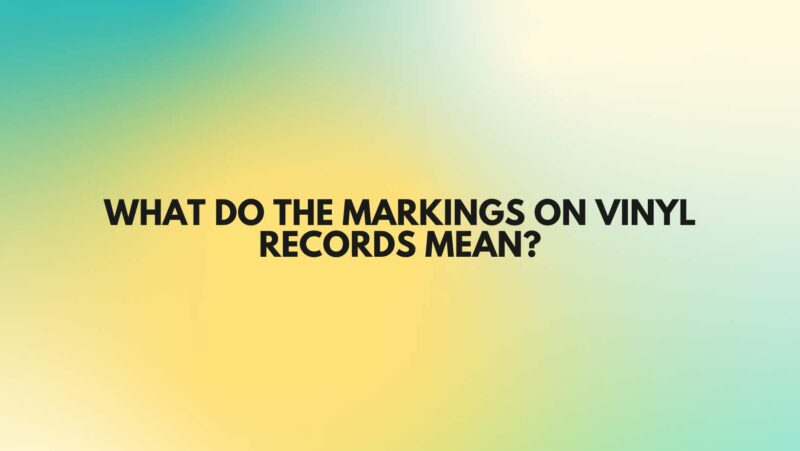Vinyl records are more than just music carriers; they are artifacts rich in history and information. The markings found on vinyl records are like cryptic codes that provide insights into the record’s production, pressing plant, and even the audio quality. In this comprehensive article, we will delve into the world of vinyl record markings, deciphering their meanings and unraveling the stories they tell.
Section 1: The Anatomy of Vinyl Record Markings
Before diving into the specifics of vinyl record markings, it’s essential to understand their basic components. Vinyl record markings usually include:
- Matrix Number: The matrix number, etched or stamped into the record’s runout groove area, is a unique identifier for each side of the record. It often includes alphanumeric characters and may include a catalog number.
- Catalog Number: This alphanumeric code typically appears on the record label and serves as a reference number for the release. It helps identify the album, single, or EP.
- Copyright Information: Copyright and publishing information is often printed on the label, indicating the legal rights associated with the music.
- Pressing Plant Identifiers: Some markings identify the pressing plant or mastering facility where the record was produced, providing valuable historical context.
Section 2: Deciphering Matrix Numbers
Matrix numbers are among the most crucial markings on vinyl records. They contain valuable information, such as:
- Pressing Plant Codes: Often, the first few characters of the matrix number represent the pressing plant or mastering facility responsible for producing the record. For example, “A1” or “A-1” could indicate the A-side of the first stamper used in the pressing.
- Stamper Identifiers: The matrix number may include stamper identifiers, such as “1A” or “2B,” which indicate which set of stampers was used in the pressing process. The first stamper generally yields the best audio quality.
- Cutting Engineer or Mastering Information: Some matrix numbers include codes or initials representing the cutting engineer or the mastering facility responsible for creating the lacquer master used for pressing.
Section 3: Historical Significance
Vinyl record markings offer a glimpse into the history of music production and distribution. Here’s why they are historically significant:
- Label Variations: Over the years, record labels have gone through changes in ownership, design, and branding. Markings may help collectors identify different label variations and release years.
- Limited Editions: Special markings or serial numbers may denote limited or collector’s edition releases, making them highly sought after by collectors.
- Bootlegs and Counterfeits: Vinyl record markings can be vital for distinguishing authentic releases from bootlegs or counterfeits, helping collectors avoid fraud.
Section 4: Collectors’ Insights
Vinyl record collectors often pay close attention to markings for various reasons:
- Audiophile Information: Stamper identifiers in matrix numbers can indicate the quality of the pressing, with early stampers often associated with superior sound quality.
- Collectible Value: Unique markings or label variations can increase the collectible value of a record.
- Identification: Matrix numbers and catalog numbers assist collectors in cataloging and identifying records in their collections.
Section 5: Preservation and Care
Preserving the markings on vinyl records is crucial for both historical documentation and collector value. To ensure their longevity:
- Handle Records Carefully: Always handle records by the edges to prevent smudging or damaging the labels and markings.
- Store Properly: Store records vertically in a cool, dry place to prevent warping and label damage.
- Protect from Direct Sunlight: Exposure to direct sunlight can fade label print and markings.
- Clean with Care: When cleaning records, be cautious around the labels to avoid wetting or damaging the markings.
Section 6: Conclusion
The markings on vinyl records are like a hidden language that reveals details about their origin, pressing quality, and historical context. Collectors, audiophiles, and music enthusiasts can unlock these secrets to gain a deeper appreciation for the vinyl records they cherish. Whether it’s identifying a first pressing or understanding the history of a pressing plant, the markings on vinyl records are a window into the rich tapestry of music and vinyl culture.

